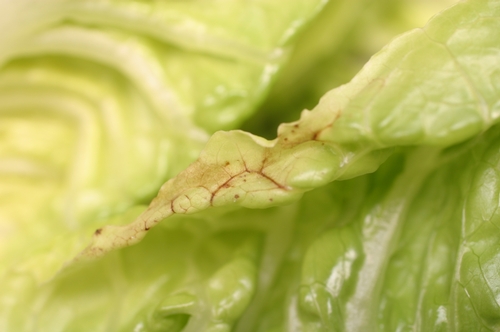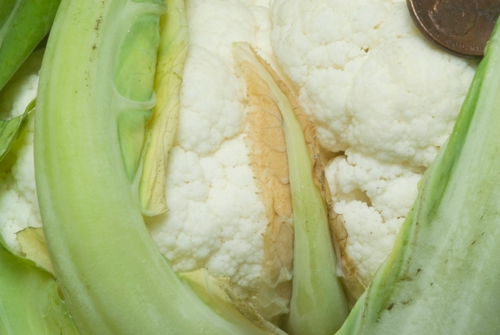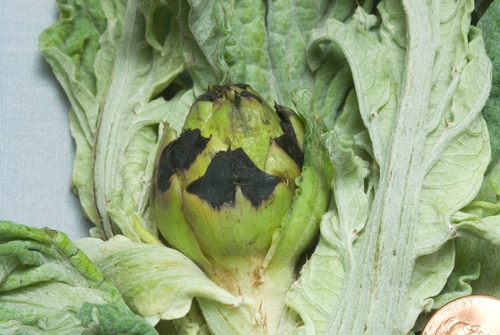In the months of July and August of 2010, a number of vegetable crops in California’s central coast were affected by calcium deficiency disorders. Usually referred to as “tipburn” (except in the case of celery, for which the disorder is called “blackheart”), these problems are often triggered by environmental factors and hence can affect a large number of acres and plantings during windows of time when tipburn is occurring in Salinas and other coastal valleys.
Tipburn symptoms on lettuce, endive, radicchio, and spinach are distictive. Symptoms occur on the margins of developing leaf tips and initially consist of light to dark brown lesions and necrosis. In romaine, tipburn is often first seen on the small veins along the margin of young leaves. In severe cases tipburn can progress and result in extensive damage to these leaf margins. Symptomatic leaves are usually found within the inner whorls of open head vegetables and underneath the enclosing wrapper leaves of closed head vegetable types. For spinach, tipburn always affects the inner, newly developing leaves which may develop a hooded appearance as the leaf continue to expand around the dead tissue. For blackheart of celery, symptoms form on the margins of developing leaf tips deep within the central growing point. Such symptoms consist of light to dark brown speckling, lesions, and necrosis. As the celery grows, the damaged tissues turn black and the affected foliage grows up and out of the inner plant whorl.
For tipburn of artichoke, the margins of immature leaves turn black as in celery. In addition, the immature artichoke flower buds develop black lesions along the upper tips and edges of flower bracts. Cauliflower also develops tipburn, with the inner wrapper leaves enclosing the cauliflower head turning tan to light brown.
Tipburn is a localized calcium deficiency. It often develops along the margins of leaves in the final weeks before harvest when the plant growth rate is at its highest. It is often unrelated to soil calcium levels. Because calcium is not very mobile within the plant, expanding tissues on young leaves and growing points may run short of this essential element and begin to develop deficiency symptoms. Conditions that favor rapid plant growth (warm temperatures and high fertilization rates) or low transpiration rates (foggy conditions) may create conditions that trigger this disorder.
Managing this disorder is difficult. Varieties vary in susceptibility, but tipburn resistance is only available in head lettuce. Maintaining even soil moisture levels and preventing the root zone from drying out helps increase calcium uptake and may reduce the risk or severity of tipburn. For field grown vegetables, soil and foliar calcium supplements have not provided consistent control.
For further information on tipburn see Monterey County Crop Notes - July/August 2007
Initial symptoms of tipburn on romaine occur on veins at the edge of the leaf.

Tipburn of butter lettuce.

Tipburn of cauliflower.

Blackheart of celery.

Tipburn of artichoke.